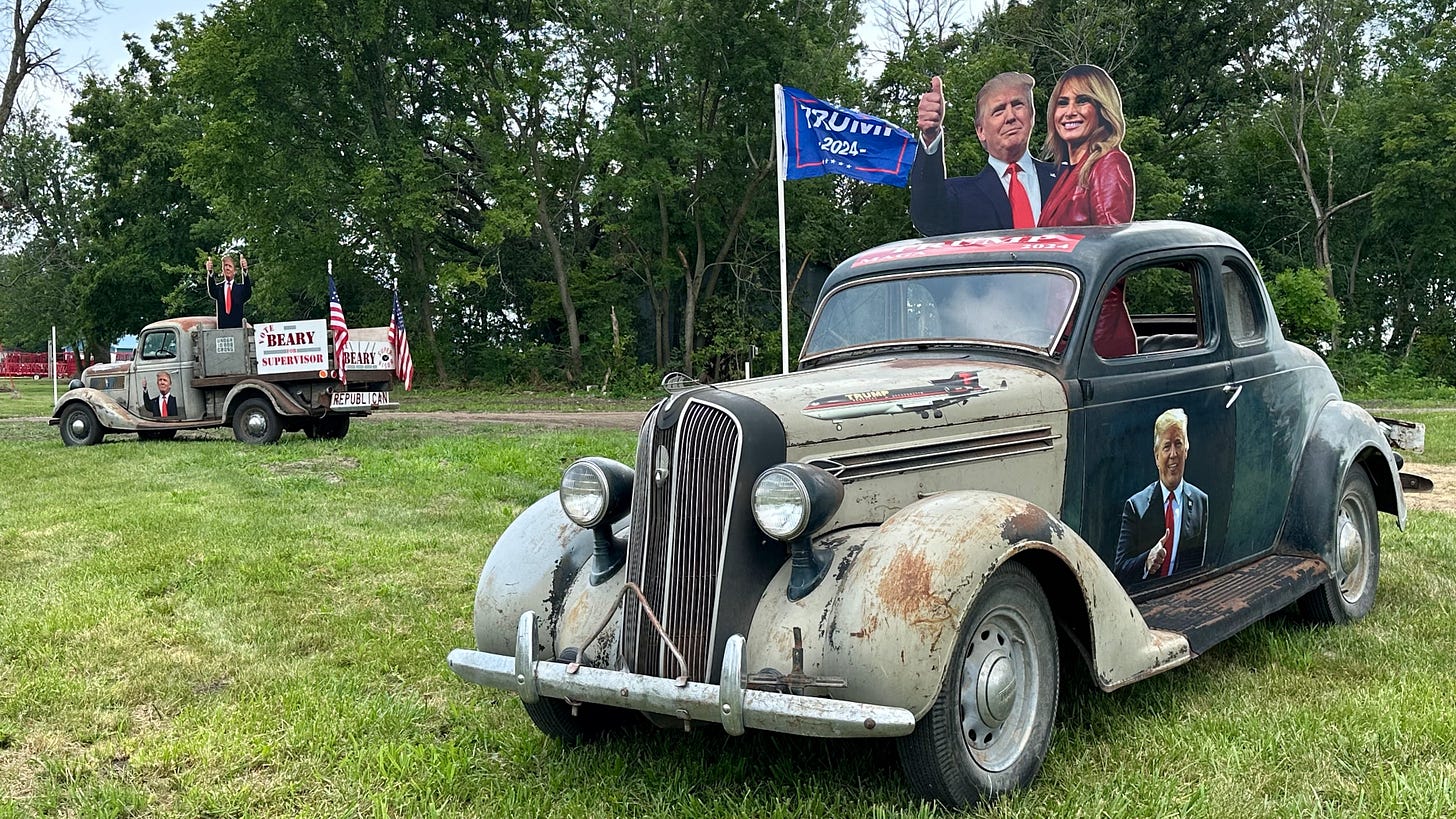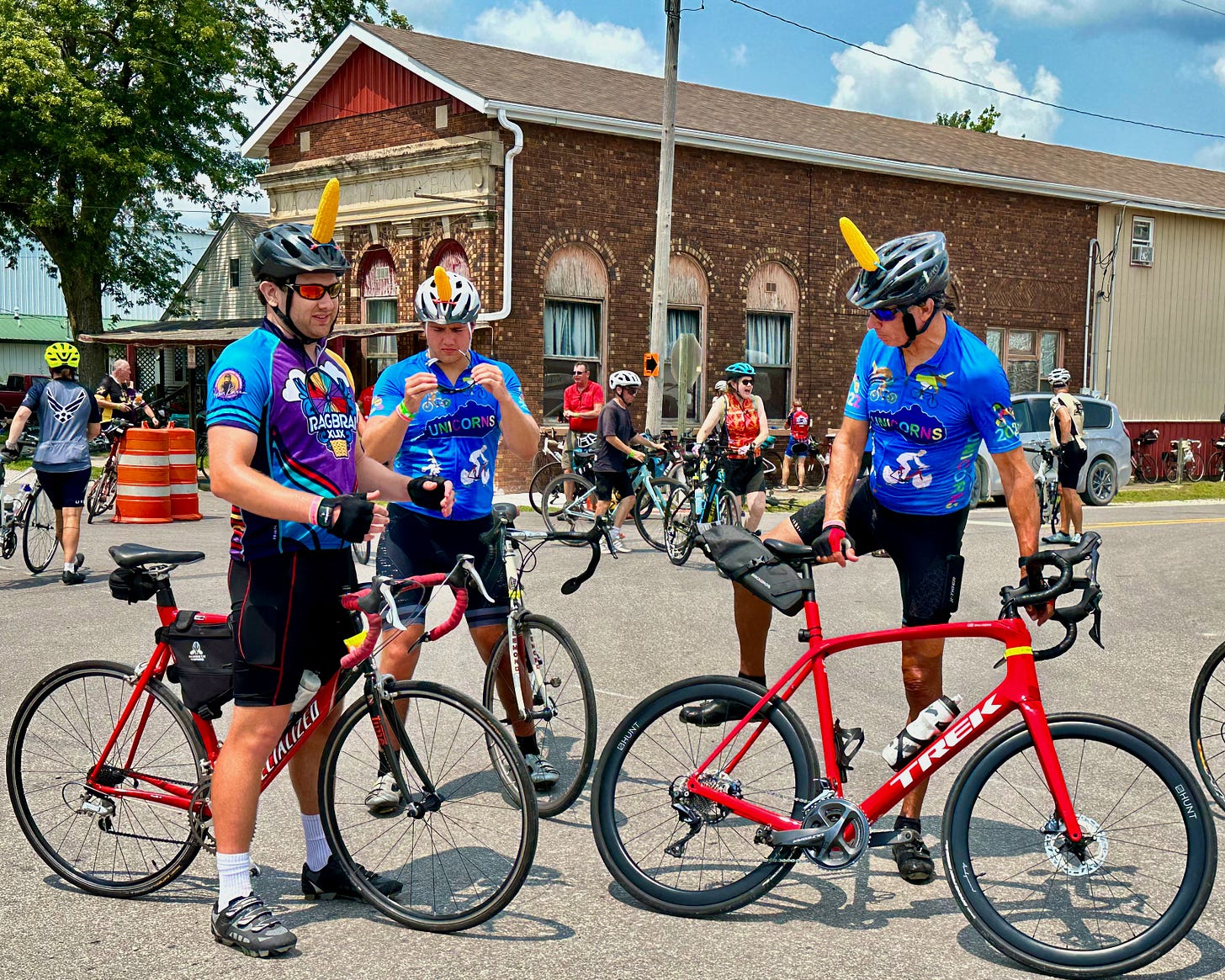RAGBRAI After the Caucuses. Biking across a Red State in an Election Year (Part 1)
What happens when people vote against their interest? Town to town, it's evident in Iowa
We are pausing our regularly scheduled programming for a special election essay. In addition to voting, after canvassing the state of Iowa in July 2024 for the (Des Moines) Register’s Great Bicycle Ride Across Iowa (RAGBRAI), I penned a 10,000-word essay on the reasons a vote for Trump is a vote against American and international interests, as I saw it across Iowa. It was not published by anyone, so here it is in digestible bits. Please read. Please read if you are undecided. Everything in Europe is not perfect, but Americans have fooled themselves if they think everything is ok at home, as Iowa illustrates.
It’s a vehicle distinct in its size, breadth and ingenuity — and other than across Iowa during the last week of every July, onlookers will likely never see it on any other occasion. The design is simple: take a school bus, set an extra-long steel platform on its top and find a set of homemade winding stairs. Weld the plate to the top of the bus and add slots for every make, model and type of bicycle, then place the winding stairs from the back of the bus to its roof. Paint the bus an eye-catching purple, yellow or green, come up with a pithy name — Shagbrai, The Dawg Pound or Cold Babies for example — and voila, the vehicle for RAGBRAI, the (Des Moines) Register’s Great Bike Ride Across Iowa, is ready to carry a gaggle of eager cyclists for the annual trip through Everytown, America.
I first encountered these buses during the annual 2014 RAGBRAI, which I had volunteered to do with my father. Ten years ago, there were only a handful of them, and I didn’t pay much attention to their particular style. I was concentrated on getting along with my father — 30 years my senior and an attorney who was hypercritical of my seemingly endless (and non-paying) struggle as a journalist — in addition to pedalling through the eighty-plus miles per day to make it from roughly Council Bluffs Iowa, where we dipped our back wheel into the Missouri River, to Davenport, Iowa, where we finished by christening our front wheel in the Mississippi River. In 2014, Dad and I didn’t make it through the ride, as he was T-boned by another rider mid-week and broke five ribs. Being the hearty Iowan descendant of Germans — as a good percentage of Iowans — my father was treated, had his broken helmet replaced and carried on for twenty-five more miles before deciding that pain trumped gain, and we quit the ride early.

In ten years, life had changed quite a bit in Iowa — in America — and in my family. Back in 2014, Donald Trump was at least a year from announcing his candidacy for president, and America was about as normal as it could get. This past summer, as I walked around the mega Wal-Mart parking lot in Winterset, Iowa and looked at the large, colorful buses multiplying at the end of a day of seemingly endless driving by factory farm after factory farm, fertilizer plant after fertilizer plant, and elaborate life-size Trump display after elaborate life-size Trump display, I realized that in this election year, Iowa was a microcosm of the divided country, even more chaotic than in 1973 when Richard Nixon resigned and Gerald Ford assumed office. Or 1986, when farmers overborrowed, riding high on export grain prices and plunged their livelihoods into bankruptcy. Or in the 1990s, when the first and second generations of German immigrants started dying off with no one to replace them in the homes and towns they left behind.
RAGBRAI had begun in 1973 as a dare between two journalists in a newsroom. Des Moines Register feature writer/copy editor John Karras, an avid bicyclist, suggested to Don Kaul — the author of the Des Moines Register’s “Over The Coffee” column — that instead of sitting in a newsroom in Washington, D.C., where he lived and worked, that Kaul set out and write columns about life in Iowa from behind bicycle handlebars. Kaul countered: he would ride across Iowa if Karras rode with him. Karras agreed and invited “a few friends” to ride with them from Sioux City to Davenport from August 26-31. Camping and eating stops were scheduled in Storm Lake, Fort Dodge, Ames, Des Moines and Williamsburg.
Thanks to only six weeks and little promotion before Karras and Kaul took off for their ride, only an estimated three hundred people showed up in Sioux City. About more than one hundred riders pedalled the entire distance that first year, which was fortunate for the Register, as no one had either driven the route or made any sort of overnight arrangements, camping or otherwise. At one point — between Des Moines and Ames — the day ride swelled to five hundred and among those, Clarence Pickard of Indianola, stood out. The eighty-three-year-old hadn’t ridden a bicycle in about twenty years and turned up with a used ladies Schwinn, but he cycled the three hundred miles to Davenport. Pickard’s attire: a long-sleeved shirt, trousers, woollen long underwear, and a silver pith helmet.
Kaul’s and Karras’ articles and columns about Iowa town life and the other characters they met along the way became one of the most popular sections of the newspaper. Letters and calls poured in from across the state. Iowans asked for the Register to hold RAGBRAI again, but a month earlier so that it didn’t coincide with the first week of school, as well as the final weekend of the Iowa State Fair. The Register scheduled “SAGBRAI,” the Second Annual Great Bicycle Ride Across Iowa, for August 4-10, 1974. For the next fifty years, Kaul, Karras and the Register’s coordinators have arranged the bike ride along dozens of West to East routes through 780 Iowa towns, hosted 326,650 people and logged 19,542 total miles In fact, the ride has become so popular that RAGBRAI officials now limit the number of week-long riders to 8,500 in order to maintain “a sense of control” and fewer injuries.
My father knew nothing of RAGBRAI until it had been running for nearly thirty years and he was fifty-five. Dad had moved from his parents’ farm in Southeast Iowa to attend law school at the University of Tulsa, and after his graduation, he helped my mother attend and also finish. After they divorced, he met my late stepmother, an Oklahoma native eighteen years his junior and another student at the University of Tulsa Law School; she became his legal intern. Nothing like the stereotypical vision of a bumbling, blonde, buxom temptress, my late stepmother, Annette was actually quite nerdy — she and my father planned on practicing law together until she hit age forty-five when they would both quit law and see the world. Following one of their many trips, Annette saw a story about RAGBRAI while browsing through a Southwest Airlines magazine. They should ride it together in 2000, she said; she would train and “get in shape for it.” Annette died in a car accident in September 1999 — just two months after her 36th birthday — while she was driving home from the personal trainer. My dad decided to ride RAGBRAI in her memory. But he kept on going… year after year after year after year.

I wasn’t around for the first thirteen RAGBRAIs, choosing to avoid the heat of Iowa summers, as well as the multitudes of family engagements. But I heard stories of him forming a team with some of his Catholic church buddies, Team Truants (one of my father’s successful attempts at using an Oxford-dictionary word to make a joke), stopping for lemonade and cookies with my grandmother, snapping a photo with the baseball-playing ghosts from Field of Dreams, riding to Davenport or Burlington or Fort Madison and finishing the seven-day journey with cases of Busch and Natural Light. My younger sister, an attorney in Oklahoma, went along with Team Truant several times, and even earned a highlighter yellow “Team Truant” bicycle jersey. I was content looking at photos. My brother had also escaped duty thus far, managing to use his successful real estate business as an excuse to avoid the ride. But in 2014 I had been through a bad break-up; I was between UN contracts; and my sister had just given birth to her second daughter.
Other than the internal disruption of a woman riding fifteen miles an hour into my father, the occasion was — on the outside of our small world — uneventful. Barack Obama was president; Joseph Biden was vice-president. The tensions in the Middle East kept flaring, but the Islamic State had yet to rear its ugly head. Orphaned migrant children had come to Iowa from the Southern U.S. border, but people were stepping up and welcoming them — or at least tolerating them. The United States didn’t have an orange-haired reality star who used to mug for Pizza Hut stoking the internalized racism and Islamophobia of a consumerist electorate, a Tea Party turning into fascist Republicans, and a country so divided that politics became a preference on Match.com. The only sign (for me) in those weeks that the American patriarchy was alive and well was an instruction from my sixty-nine-year-old-white-male-attorney-father to his friend: “Don’t worry about waiting up for Adrian, Charles, she will be well behind you.” I had to stop at every rest stop to make sure the friend, a Tulsa-based news anchor named Charles Ely, had not had a heart attack.
A little more than two years later, the United States became a version of itself that not even I, a former Republican-prep-school-kid, could recognize or explain. The Tweets of an deranged man became daily news and the populist candidate gave an unhinged populace permission to listen to the devil on their shoulder when social issues, such as immigration, care for the poor, police brutality, racism and later on, vaccinations and mask-wearing, arose. I found good work reporting on Trump and the daily news for a South African talk news station with serious presidential schadenfreude, but when my English partner lost her job at a business travel company in 2020, we decided to find a better way of life. We chose home for her: London.
I knew the Brits and Americans shared most parts of a common language, but little else. Because I already liked “socialism light” — an alternative to the hyper-capitalism of the States — I took nicely to the green spaces, the proximity to Europe, the old buildings, trains that went almost anywhere at most times, the ethnic feel of new immigrant neighborhoods and of course, the health care. The people posed another challenge. They didn’t care for Americans that much, and while the rigidity of the English annoyed me, the distaste for American values and American exceptionalism sunk into me. By the time Dad and I arrived for RAGBRAI 2024, I noticed that I had lost tolerance for Midwestern Americans. I had spent one day in Oklahoma.
Once we finally reached West Des Moines, Iowa and RAGBRAI, I knew I had to write my thoughts, town-by-town, ala Karras and Kaul, of the ride across the Hawkeye state — a state once made up of millions of German, Dutch and other immigrants, as well as Native Americans; a state that collective fought against slavery in the late 19th century; a state that welcomed Franklin D. Roosevelt’s New Deal policies; and a state known for its wide range of political viewpoints. Among the towns, I realized that not only was Iowa important because of its caucuses in election years, but also because every town symbolized all of the problems in America and the potential of a Trump presidency to exacerbate them.









Loved this. Great job!